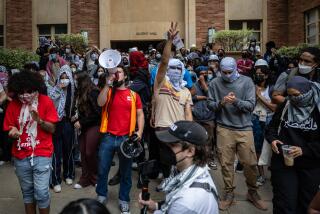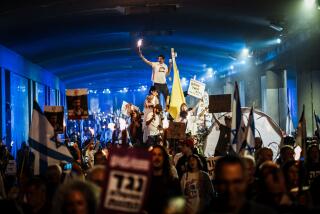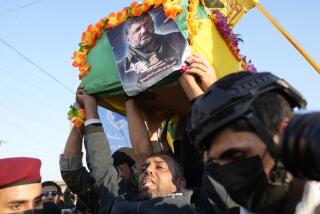For Baghdad’s Sunnis, Hostility Toward Occupation Is Growing
BAGHDAD — It began as a pro-Saddam Hussein march in the capital’s Adhamiya district and turned into a raging gun battle with U.S. armored units surrounding a dozen fighters. When the smoke cleared, seven Iraqis lay dead.
A week after the bloody exchange, the bitterness left behind in this northwest Baghdad neighborhood with strong ties to Hussein and his Sunni sect illustrates the challenges facing the U.S.-led coalition, even with the former dictator behind bars.
In Sunni enclaves like Adhamiya, there is increasing hostility toward occupation forces. The ill feelings derive not only from die-hard loyalty to Hussein but also from mounting frustration over the breakdown of municipal services and security, and Sunnis’ sense of exclusion from Iraq’s reconstruction. Many residents here are former Baath Party members or bureaucrats who were purged from the government and haven’t received a paycheck in months.
“The Americans are creating enemies for themselves who will help the terrorists,” said Amar Hashimi, a respected former Iraqi army general and member of the Adhamiya neighborhood council.
“Before, a minority was against the Americans,” added Sheik Sabbah Naja Adhamiy, another council member. “Now it’s the majority.”
On Sunday, the shootout was the focus of the weekly neighborhood council meeting, and U.S. army officers attended to discuss the incident. But reconciliation proved elusive: Hashimi and 11 other members of the 25-person council walked out after the Americans refused to apologize. Many council members -- including President Luqman Jassim and Hashimi -- said they might resign.
The gun battle in Adhamiya was one of many clashes that erupted following the Dec. 13 capture of Hussein. The clash occurred as U.S. troops tried to disperse a pro-Hussein march down the main street of the district.
Some marchers wore ski masks and carried firearms as they demonstrated in the shadow of the 800-year-old Abu Hanifa shrine, a destination for thousands of Sunni pilgrims. The square in front of the shrine was the last place Hussein was seen in public, on April 9, before going into hiding.
The Coalition Provisional Authority has decreed all such marches illegal. Army Col. Pete Mansoor, commander of the 1st Brigade, 1st Armored Division, and Lt. Col. Bill Rabena, both of whom attended Sunday’s council meeting, initially sent a small Iraqi police force backed by a score of U.S. troops, including military police, to disperse the crowd.
But when one of the American MPs was fired upon, and four U.S. troops were wounded by a grenade, the commanders sent in reinforcements. Soon, about 300 U.S. troops backed by 10 Abrams tanks and four Bradley fighting vehicles were converging on the square. Before long, U.S. troops were taking fire from gunmen using AK-47s and rocket-propelled grenades, and the firefight was on.
When the shooting stopped, seven Iraqis lay dead, including two bystanders, Hashimi said.
Mansoor told the council the use of force was justified after his troops were fired on with AK-47 rounds and RPGs. He told the council to send a message to the “armed thugs that if they want to turn Adhamiya into a battle zone, bring it on.”
But Hashimi and other residents say the incident could have been avoided had the marchers been left alone.
“Let the people shout for one or two hours, they get tired and they go home, and the business is completed,” Hashimi said. “Saddam was president for 35 years. Do they think they can erase him in one minute or one night by calling the police? What happened to your Statue of Liberty? Change the name.”
Imam Moayed Adami, the religious leader of the Abu Hanifa shrine, said in an interview Saturday that the coalition’s ban on pro-Hussein marches is “against the principles of freedom.”
But after 12 of the council members walked out of Sunday’s meeting, member Ghazi Alboudi stood up and said that allowing pro-Hussein marches would be an insult to the ex-dictator’s thousands of victims and their families.
“My mother and I were arrested and imprisoned together,” Alboudi said. “I will never forget having to listen to her being tortured and humiliated in the adjoining cell. To allow these demonstrations would not be civilized.”
Mansoor told the council that doing nothing in the face of an illegal march that included members of the Saddam Fedayeen militia and possibly foreign fighters would have resulted in bigger demonstrations.
After the gun battle, 23 people were detained, including three Egyptians and several other people with known links to the Saddam Fedayeen. Two had bullet wounds less than 24 hours old that may have come from previous encounters with U.S. troops, Mansoor said.
But one victim was a neighborhood character, Shamil Nafi, a 44-year-old father of four who was in the wrong place at the wrong time. He was an ex-policeman who, like many Sunnis, had been purged from the nation’s security forces. Hashimi said the neighborhood council was paying him $3 a day to do odd jobs.
On Wednesday, at the Hall of Condolences a block off the main square, a banner proclaimed Nafi a “martyr,” stating that he died fighting “American occupation.”
Despite last week’s violence, Rabena said, his forces are slowly subduing the resistance and the number of bomb attacks against U.S. forces is declining.
“The former regime elements here are on their last legs,” said Rabena, whose troops occupy a bombed-out Adhamiya palace once inhabited by Hussein’s son Uday.
But in interviews, local residents voiced support for the anti-American fighters and Hussein, even though many said they had no special loyalty to the dictator when he held power.
“He was an Arab, he stood up to the Americans, and the country functioned better under him than under the occupation,” said Mohammed Ali Eden, 49, an unemployed father of eight who used to work in Hussein’s protocol department. Now, his family is scraping by on his wife’s $50 monthly salary from a local factory.
Pointing to a mile-long line of cars snaking toward a downtown gas station, Khalid Mossem, a former army soldier, asked: “This is democracy?”
Jassim, the neighborhood council president, said he was leaning toward returning to Yemen, where he spent 12 years in exile before returning to his homeland in April after the fall of Hussein.
“I have never seen such a situation. No water, no telephones, no gasoline, no municipal services,” he said. “We are living in panic and poverty.”
More to Read
Sign up for Essential California
The most important California stories and recommendations in your inbox every morning.
You may occasionally receive promotional content from the Los Angeles Times.










